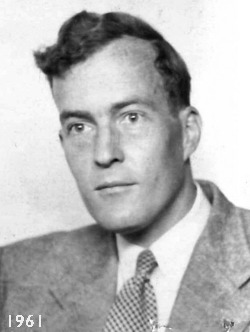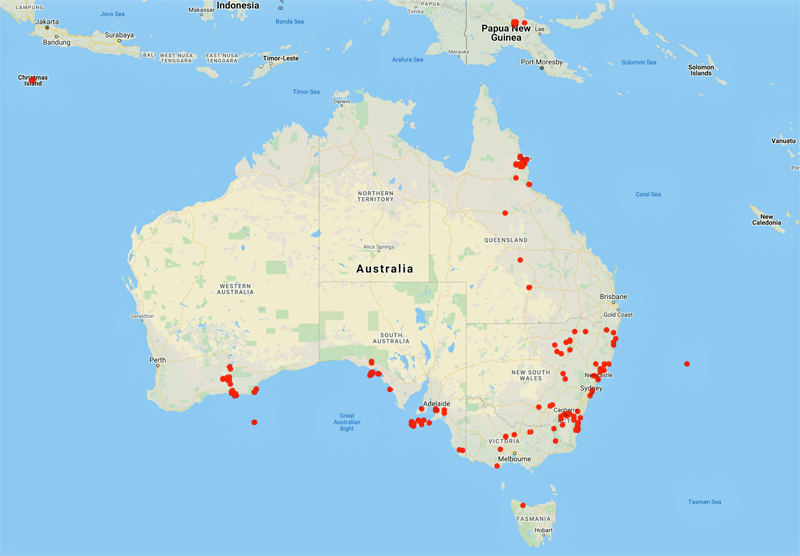
Council of Heads of Australasian Herbaria
Australian National Herbarium
Biographical Notes
 |
Council of Heads of Australasian Herbaria |
 Wace, Nigel Morritt (1929 - 2005)
Wace, Nigel Morritt (1929 - 2005) Nigel Morritt Wace was born in India on January 10 1929 and died in Canberra, Australia on 4 February 2005.
He was the only son of Sir Blyth Wace, Commissioner and Secretary to the Government of the Punjab. The family claims descent from Wace, the 12th-century Jerseyman and chronicler of the House of Normandy. Young Nigel attended Brambletye School in Sussex before going to Sheikh Bagh preparatory school in Kashmir, where a strong emphasis on outdoor activities left him, he said, with "a continuing delight and inquisitive interest in different sorts of landscape and people".
Having completed his schooling at Cheltenham, Wace was commissioned in the Royal Marines in 1947, but two years later was invalided out with tuberculosis. He then went up to Brasenose College, Oxford, to read Agricultural Economics, before switching to Botany. His first visit to Gough Island was the result of meeting John Heaney, who also went to Sheikh Bagh, on a skiing holiday in Switzerland. After returning from Gough in 1955, Wace became an assistant lecturer at Belfast, then worked for the British Council in London (where he loathed the bureaucracy).
Following his marriage to Margaret White, a secretary at the British embassy in Athens, with whom he was to have a son and two daughters, Wace joined the Geography department of Adelaide University, South Australia. After two years he moved to the National University at Canberra. He served there for many years as lecturer and head of the university's department of Biogeography and Geomorphology.
Tristan da Cunha Islands
Nigel Wace was the leading authority on the plant life of the four Tristan da Cunha Islands, which are midway between South Africa and South America.
Wace made his first visit to Tristan da Cunha and its neighbour, Gough Island, in 1955, as a member of an expedition, under the leadership of John Heaney and Martin Holdgate, which carried out a study of the islands' geography, geology, biology and meteorology. During their six-month stay on the uninhabited Gough Island, where Wace identified some 12 plant species found nowhere else in the world, the expedition team built a base which was subsequently handed over to the South Africans, who maintain a weather station there.
Wace was primarily concerned with vegetation, but, like his seven colleagues, he became very aware of the huge number of wild house mice - an introduced species - all over the island. Specimens collected by the expedition showed that they were the largest house mice in the world. Although the expedition did not catch any of the mice in the act of killing baby albatrosses - as they have recently been reported doing - they noticed that the rodents would nibble people's hair when they were asleep in camp on the mountains.
Wace produced the first detailed description of the Gough Island's vegetation, and this later earned him a PhD from the Queen's University, Belfast. After the volcanic eruption on Tristan da Cunha in 1961, he collaborated with Jim Dickson to prepare what is still the most authoritative overview of the flora of the Tristan islands' group. For six weeks in 1968 Wace returned with Holdgate to Gough and to Tristan da Cunha in order to produce a monograph on the interaction of man and nature since the islands' discovery by Portuguese navigators in the early 16th century. Wace was indignant that the discoverer of Gough Island, Goncalo Alvarez, was nowhere commemorated on the map, and campaigned successfully to have the second highest summit renamed Goncalo Alvarez Peak. On further visits in 1976, 1984 and 1995, he drew up proposals for the prevention and elimination of invasive plants, and urged that action be taken against the house mice. He also vigorously campaigned for Gough Island to be declared a world heritage site.
Australia
He contributed greatly to knowledge of the Australian flora, both in settled parts and in the outback, recalling how a grazier at an outback station greeted him as his first visitor in six months. In later life, Wace acted as a guide and lecturer in cruise ships to the Antarctic. Like Darwin, he had always been interested in the distribution of seeds around the world, and he liked to encourage passengers to drop bottles with messages inside them into the sea. After a "bottle throwing party" in Drake Passage, at which passengers inserted 80 messages with a return address at Canberra, he was delighted when one was was recovered in New Zealand and another on Easter Island, confirming the pattern of circumpolar drift first demonstrated by Sir James Clark Ross in 1842.
Ever the expatriate Pom, Wace was a man of boyish charm, always devising new ploys to entertain; he never failed to fascinate friends with his "rolling rabbit run", in which rabbits in a cage moved it along to eat fresh grass. He also devised "Operation Weed", which involved asking anyone he met for the definition of weeds, often beginning with "D'you think there were weeds in the Garden of Eden?", going on to discuss whether they could be classified as weeds before the Fall. Wace enjoyed investigating the mud collected on car tyres or in trouser turn-ups, to demonstrate their role in transporting seeds around Australia.
Source: Extracted from: http://cfyn.ifas.ufl.edu/
Portrait Photo: 1961, Adelaide University, https://connect.adelaide.edu.au/nodes/view/5031
I have just retired from working at Lizard Island Research Station for 23 years and came across the poem by Nigel Wace below, which I found at the station in 1988.
I am sure Louis Carroll would not take offence.
Lance Pearce (March 2012).
The surfie and the greenie fair were walking on the beach,
Hand in hand along the sand for each was fond of each
They loved to walk beside the sea, for so much could it teach.
The sun was shining on the sea, shining with all its might,
He did his very best to make the billows smooth and bright
And this was odd, because the beach displayed a horrid sight.
The sea was wet as wet could be, The sand was dry as dry,
You could not see a cloud because, no cloud was in the sky;
But bottles, plastic, ropes and gunk along the beach did lie.
The Surfie and his Greenie fair were feeling rather sad,
They wept like anything to see a beach that looked so bad.
If this only were cleared away, we'd both be very glad.
If seven blokes with seven sacks scavenged for half a year,
"Do you suppose" the Surfie said "that they would get it clear?"
"I doubt it" said the Greenie green and shed a bitter tear.
First, there's all the picknickers and others of their kind
They come here to enjoy the beach - but rubbish leave behind.
Thongs, and plates, and plastic bags - they really must be blind.
And then, there's all the industries with factories near the shores,
Their litter washes down the creeks - and on the beach doth pause,
Plastic foam and packaging - against pollution laws.
Lastly, are the mariners upon the ocean blue,
With litter louts aboard the ships - (both passengers and crew).
In shore and offshore fishermen, with floats and driftnets too.
'The oceans are all full of gunk, across the world so wide -
It keeps forever floating in on each and every tide;
People just chuck things overboard - both port and starboard side.
Two-thirds the surface of the earth is occupied by sea;
Our planetary rubbish tip it will too easily be;
Unless we try to keep it clean and that means you and me.
Nigel Wace
Data from 1,284 specimens
